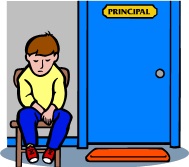People have many misconceptions about special education programs and students. There is even a hint of fear in the faces of visitors to schools with active special education programs. People aren’t mean, just ill-informed. It’s true that many special education children need extra discipline to thrive. Structure seems to be so very important to many children. Structure gives kids a sense of security; it’s always good to know what’s expected of you. This is the crux of any classroom management program, carefully defined and communicated expectations.
It’s not surprising that student discipline is a major issue when discussing special education. Discipline is a hot button for many parents. They want to be very sure their children are treated fairly when any type of punishment is administered. Special education students have all the rights of due process that any other student may have, but they are also protected further by their IEP’s.
In school, students are generally expected to follow a set code of conduct. That conduct is interpreted throughout the school by both teachers and administrators. In individual classrooms the teacher is responsible for keeping order but has some fairly wide latitude in most schools about what will be allowed and what will not. A school with great leadership will have a consistent and fair set of codes of conduct for all children, but special education teachers are brought into the planning of the expectations early in the process.
The committee that meets to develop each IEP must determine if a student’s disability is defined by particular types of misbehavior. In other words, a typical student who curses aloud in class would be punished for disrupting the class and making poor choices. But a special education student that has been diagnosed with Tourette syndrome would be doing no more than exhibiting a characteristic of his/her disability. To punish that person would be like punishing another student whose temperature went up because he had the flu.
Similarly, students with AD/HD may call out more often than other students. They will also wiggle more and get up and move around the class. These are not behaviors the teacher wants to ignore, but the key is to continually remind students of what appropriate behavior looks like in your school.
Most IEP’s include a discipline plan so that special education students face certain consequences for their inappropriate behavior. Many districts in the country are working on professional development programs with a protocol called RTI (Response to Intervention). It’s a leveled set of guidelines that define how a student will learn and behave. Teachers are being trained to use it to provide additional structure and support in the classroom.
It’s also a way to prevent unnecessary referrals to special education classrooms by teachers who are struggling with classroom management issues. With this program, it is carefully spelled out what is expected, and it provides ways for teachers to intervene on behalf of a student who is taking longer to adapt to the classroom rules than others.
Parents need to understand the programs schools have adopted for classroom management and discipline. This high level of understanding helps them become better partners in the education of the children.
Grant Name: Standard Charitable Foundation Grants
Funded By: Standard Charitable Foundation
P: 971.321.3162
F: 971.321.5243
The Standard
Public Affairs P12B
1100 SW 6th Ave
Portland OR 97204
Description: Areas of funding interest include Community Development, Education Effectiveness, Disability and Health.
Program Areas: Adult Literacy, After-School, Arts, At-Risk/Character, Community Involvement/Volunteerism, Disabilities, Early Childhood, Family Services, General Education, Health/PE, Homeless, Math, Reading, Safe/Drug Free Schools, Science/Environmental, Social Studies, Special Education.
Recipients: Public School, Other
Proposal Deadline: 5/1/14
Average Amount: varies
Website: click here
Availability: All States


